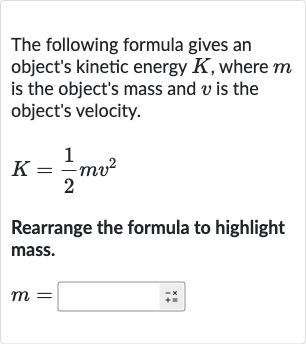Full solution
Q. The following formula gives an object's kinetic energy , where is the object's mass and is the object's velocity.Rearrange the formula to highlight mass.
- Write formula for kinetic energy: Write down the original formula for kinetic energy.
- Isolate mass term: Isolate the term with mass on one side of the equation.To do this, we need to get rid of the fraction and the velocity squared term that are multiplied by the mass.First, multiply both sides of the equation by to eliminate the fraction.
- Eliminate fraction and velocity squared term: Now, divide both sides of the equation by to isolate .
- Multiply both sides by : Check the rearranged formula to ensure it is correctly solved for mass . The formula now reads , which correctly expresses mass in terms of kinetic energy and velocity .

